Ever wondered how to make prosciutto? Or even something similar at home? It's a great piece of pork charcuterie, but a difficult one to make well at home unless you have some serious patience. Read on and I'll explain.
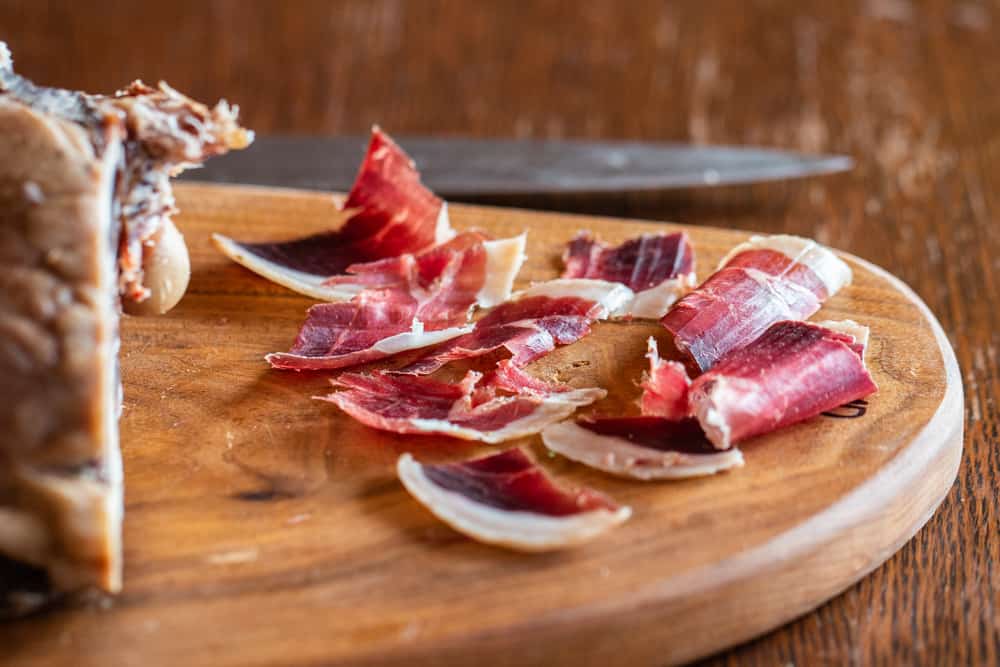
Back at Heartland restaurant in St. Paul when I worked under Chef Lenny Russo, if there was going to be prosciutto on the menu, we made it in house—all of it. Mostly the prosciutti we made were pork, and they took a good 18 months, but sometimes there would be boar too, and we could get away aging those for about 12 months.
I love, love cured meats, especially prosciutto, but I don't have the set up (or the patience) to age anything for 12-18 months right now.

Last year in the summer, while I was doing research for my book, one of the books I was reading had something that made me think differently about the process and if it would be worth doing prosciutto or something similar at home. The book was The Little House Cookbook, inspired by the Laura Ingalls Wilder series, with many of the passages (and recipes where possible) in the book coming directly from the original texts.
One of the passages (I don't know exactly which book it was from) talked about Pa hanging a pork leg in the chimney for a time to cure it. I don't remember how long the leg was in the chimney, or if it was hung afterword, but I would assume it was. Either way, it changed my tune.

Hanging ham: a seasonal tradition
Curing and hanging meat used to be a seasonal thing. Fall came around, and the animals who'd been around the yard for the growing season would be hard to feed during the winter. Pork would be salted, smoked, to provide food throughout the winter, or, in the case of ham, often aged until Spring, which is one of the reasons people eat ham around Easter.
Sure, typical prosciutto takes a long time, but that's because pork legs are large. Salting, smoking and hanging a leg of lamb, goat, or venison at home would go much quicker, and I thought it would be fun to put one up early in the winter to take down in the spring.
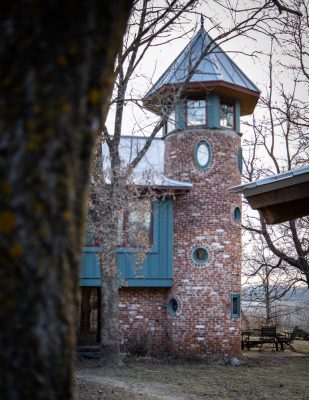
I didn't have a chimney like Pa, but I did have a smoker. And, I also had a secret weapon: a tower connected to the house that stays at roughly the temperature of a fridge during the winter where I knew I could hang a leg of lamb, goat, or deer without it freezing, which would mess up the process.
Prosciutto vs Speck vs Country Ham
Lets get something straight for the sticklers though. Technically, what I wanted to make was more along the lines of American country ham, or speck, one of my favorite cured pork products that hails from the Dolemite mountains in Northeast Italy.
Speck is ridiculously good, and just a couple shavings will bring flavor to all kinds of things, especially if you sweat it in butter. American-style country hams like the famous Smithfield loved by James Beard are very similar, but aren't aged half as long as speck or prosciutto.
Fenalår
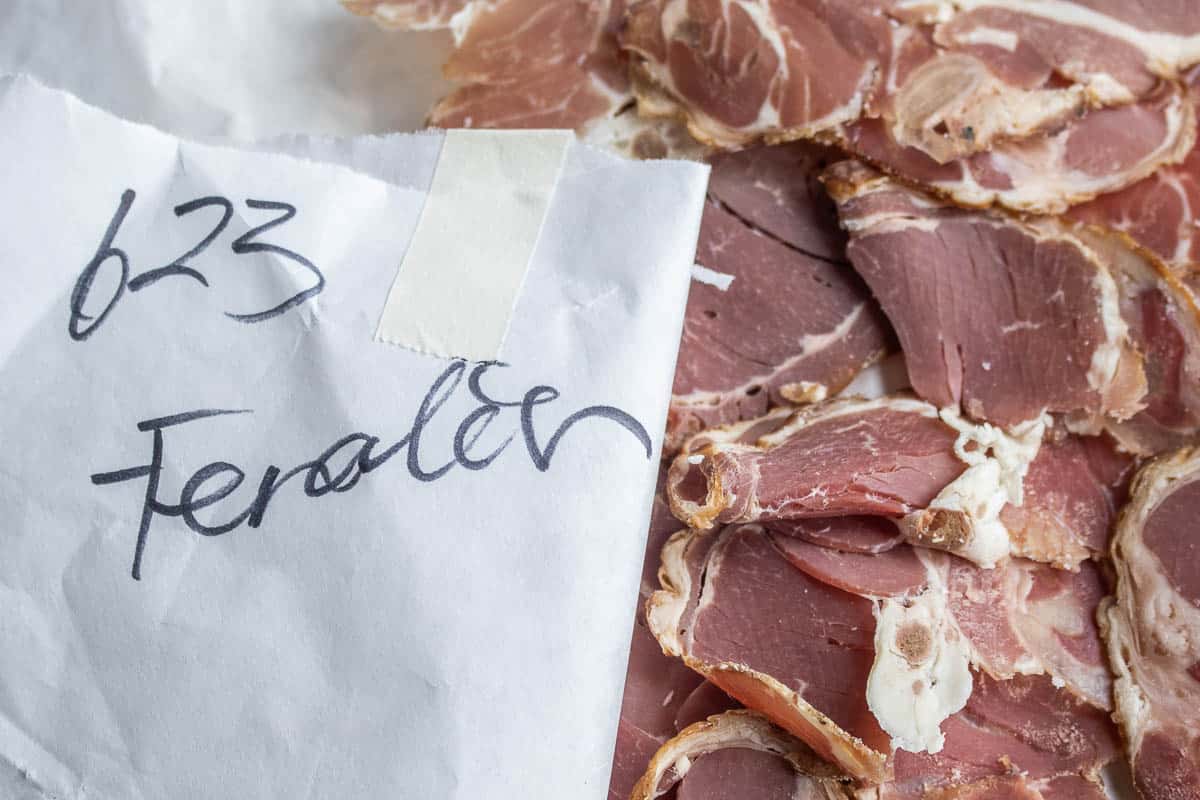
Another analogy here, and, in all honesty probably the closest one to the finished product here is Fenalår, a smoked mutton ham traditionally made by my viking ancestors in Norway.
Just like prosciutto, mutton legs are salted, but then are held in a room with a wood fire to keep them from freezing, which also smokes them in the process. Above is a picture of fenelar I bought, which you can see has obviously been treated with sodium nitrate and cooked, giving it the texture of a common ham. If you're in Minnesota, Ingebretsons is the finest Scandinavian food store we have--they even make their own salted pork trotters and blood sausage!
 Salting and Curing
Salting and Curing
One big question I had to work out was how to apply the salt and initial cure to the leg. There's lots of info and opinions out there, but here's my opinion.
Pink salt or no?
Typically with charcuterie I'm a stickler for using a gram scale to measure out my seasoning and cures. But, I'm pretty sure Pa didn't use a gram scale for his ham, and neither did the Romans or the Gauls before them.
If I'm making terrines, bread and brines, yes, I'll use a scale to measure my salt, but for a rustic, homemade, salt-cured ham, I don't think it's necessary. But, if you're new to curing, you might consider using instacure #2 (sodium nitrate) both for the flavor it adds, and for the added protection from spoilage.
Bactoferm
Bactoferm is a freeze-dried culture used in making salami. This is the bacteria that helps give the white mold to cured meats you see on the outside, giving them mushroomy flavor notes. The culture also helps acidify and jump-start the fermentation process, and it's a good thing to keep in mind if you're new to curing. It's cheap, and a little goes a long way.
Smoked, for a week
After salting, I smoked the ham for an entire week to mimic Pa's chimney. This was at the end of October, when the temperature is only hovering around freezing at night. What I did, was leave it in the smoker with the door propped open, smoking at the lowest possible temperature. All. Day. Long.
During the nights, I left the leg outside, since I knew it wasn't cold enough to give it a hard freeze. Smoking here is interesting to consider for it's preservative qualities. Our ancestors knew, probably intuitively, that smoking helped preserve food, but probably not why.
One of the reasons is probably because smoke creates nitric acid, which helps preserve the meat, and probably helped keep flies away if meat was cured in warmer parts of the year and hung outside.
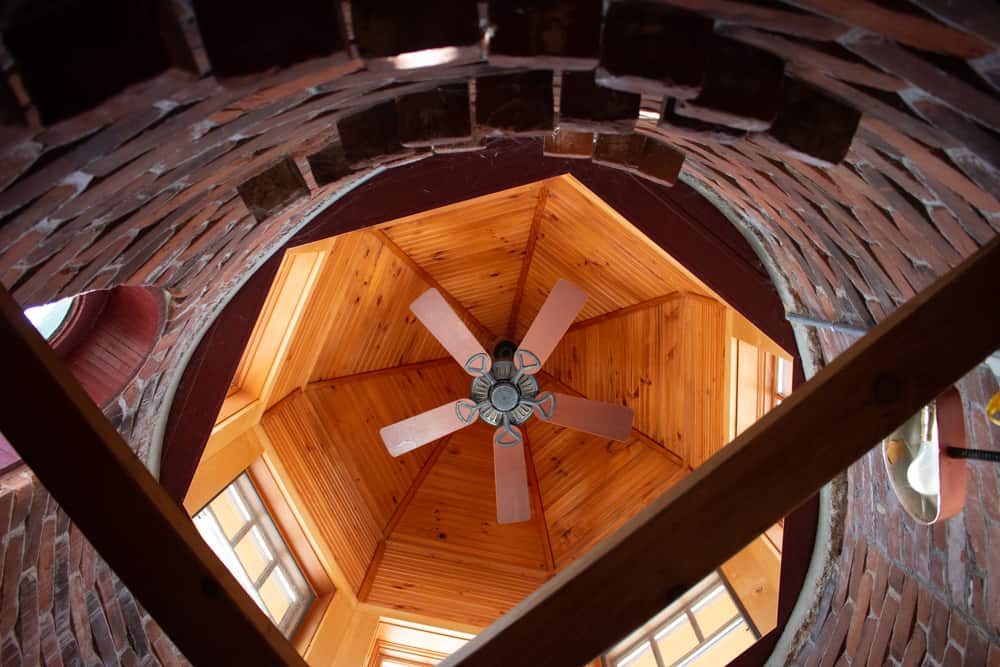
To make sure the smoking wouldn't cook my lamb ham, I set it to smoke with the door propped open and put the probe in the middle of the smoker to test the temperature first. It never got above 45-55F, so that was good enough for me. Sure enough, even after 8 hours of smoking, when I'd reach my hand inside the smoker, the lamb leg was still cool to the touch.
Improvising the week-long smoking
I used a stand-up, vertical smoker, with the leg at the top of the smoker to get it as far away from the heating element as possible. You could probably do something similar with a pellet grill by leaving the door wide open and figuring out a way to prop the leg up to get it away from the heating element. You could also just build a fire and hang the ham nearby/downwind from it, which would do the same thing. It's not an exact science.
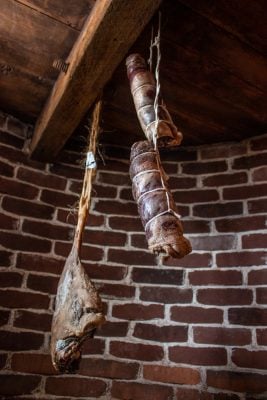
Hanging
After I smoked the salted leg of lamb for a week, I weighed it, then tied it up and stuck it in the tower, checking on it here and there, until it had lost about 30% of it's weight, at about the 3 month mark. I knew this part would be tricky, since I didn't have a way to control my humidity. Pa didn't have a humidifier, so I didn't feel the need to put one in the tower. I wanted to keep it rustic.
Humidity
There's lots of instructions on how to properly age a country ham or prosciutto, starting with a high humidity and decreasing it as time goes on to prevent case hardening. If you really want to make the perfect DIY prosciutto, research that, by all means, just don't let worrying about it stop you from experimenting.
Lamb, goat, and venison hams, as they're going to be skinned first, are all going to get a little dry, and it won't be the end of the world. Remember people have been curing and aging meat in far more "rustic" conditions than the spot in your garage or basement you might use to hang your ham, for a very long time.
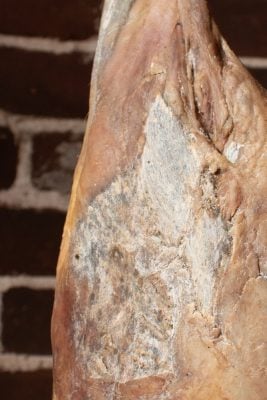
Case Hardening
The nice thing about a leg of pork is that they have the skin on, and that layer of fat protects the meat. I skin all my lamb and deer legs though.
Skinned legs mean you have exposed muscle protein, it that will eventually dry out, giving way to a process called "case hardening" a toughening of the meat that can prevent moisture from evaporating.
I knew I'd probably get some case hardening on my smoked lamb ham, but since I was only planning to age it for 3 months or so until the spring thaw, I figured it wouldn't be too big of an issue, and it wasn't.
After a few months of aging, I took the leg down, trimmed it up, and, portioned it into a few packages so I could mete it out as needed.
The flavor was excellent: smoky, meaty, with plenty of aged funk reminiscent of prosciutto and speck. Is it true homemade prosciutto? No, mine wasn't quite as firm, but it was close--pretty darn good for only 3 months of hanging. Is it about as close as I care to get with no investment or special equipment? Absolutely.
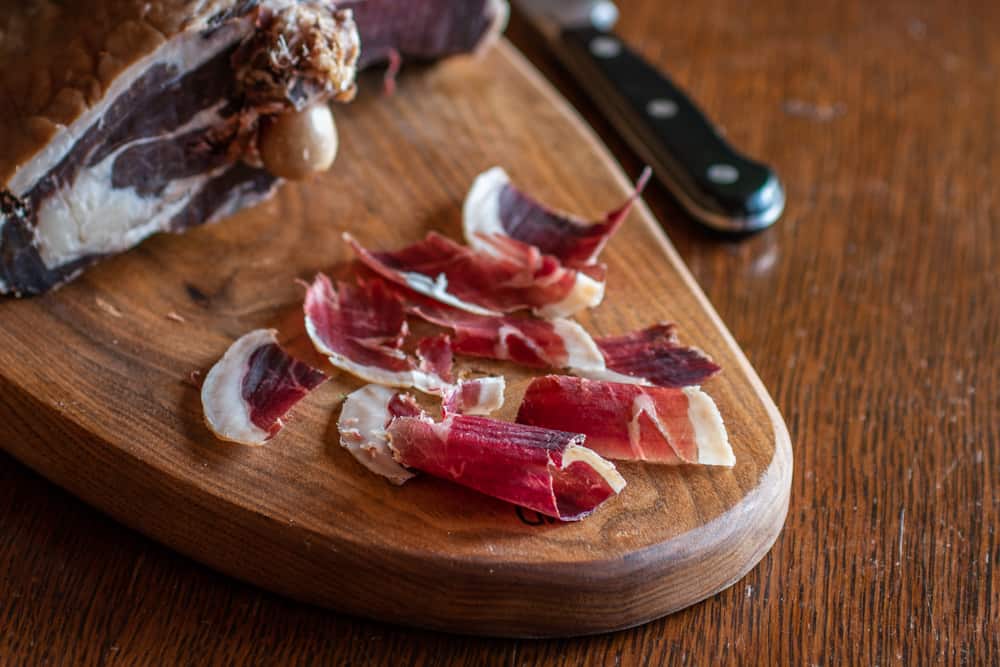
More Lamb Recipes
Smoked Lamb, Goat, or Venison Prosciutto / Country Ham
Ingredients
- 1 large lamb, goat, or venison leg, with shank, about 6 pounds
- 1 cup kosher salt or 8 teaspoons (40 grams) per pound kosher salt for legs of other sizes. This is more than you need, but you can't really over salt this.
- 2 Tablespoons whole black peppercorns
- 1/16 teaspoon Bactoferm culture optional but highly recommended
- 1 teaspoon instacure no2 optional, not to be confused with instacure no1.
Instructions
Salting
- Grind the peppercorns to the consistency of rough sand and combine with the salt, bactoferm and instacure no2 if using.
- Rub the leg well with the salt mix, making sure to mind the ball joint and put extra salt around there. Keep the leg on a tray in a fridge, flipping every other day or so, whenever you can remember.
- After two weeks, remove the leg and pat it dry completely.
Optional Smoking
- Cold smoke the leg for 1 week, or at least a couple days, trying to keep smoke on it for about 4-8 hours each day, making sure the temperature doesn't get too warm by keeping the door of the smoker open, or a similar arrangement. You can aim for anywhere from approximately 45F-65 F here. This is not an exact science. If you have a way to cold smoke the leg you prefer, do it. The biggest thing to remember is that you don't want it to cook.
Hanging
- Weigh the leg, write down the weight on a piece of tape or something similar. Tie the leg up and hang it in a cool, dry place for 3 months that won't freeze, with a temperature somewhere in the range of 40-55F, give or take a few degrees, keeping it cooler in the beginning as much as possible. Attach the tape with the starting weight to the string you used to hang up the leg.
- As the leg cures, check on it here and there. If you see anything *other* than white mold a la camembert growing on it, spot treat/rub those parts with a towel wet with white vinegar until it's gone. White mold is normal and desirable.
Finishing and vacuum sealing
- After 3 months, or when the leg has lost 25-30 % of it's weight, remove it, carefully cut out the bone, and vacuum seal the entire leg in a bag. Refrigerate the cured leg for 1 week to soften the meat. Save the bones to make really good stock.
- After a week, trim off any still very hard portions of the outside crust, vacuum seal large chunks of your ham you can shave thin with a sharp knife.
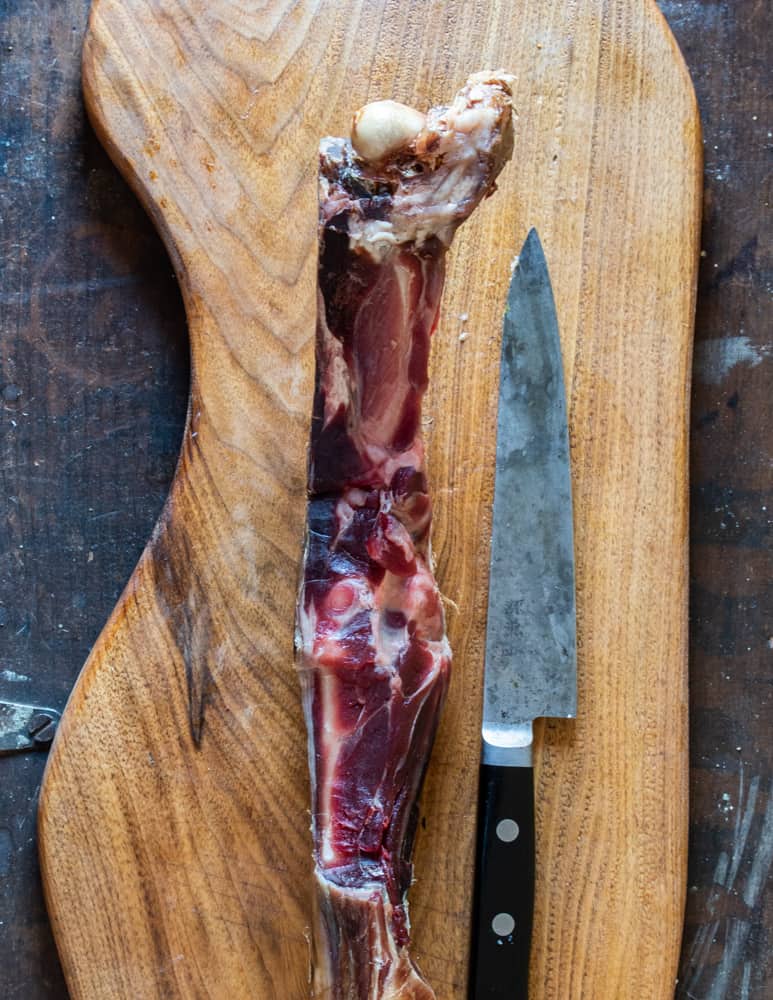

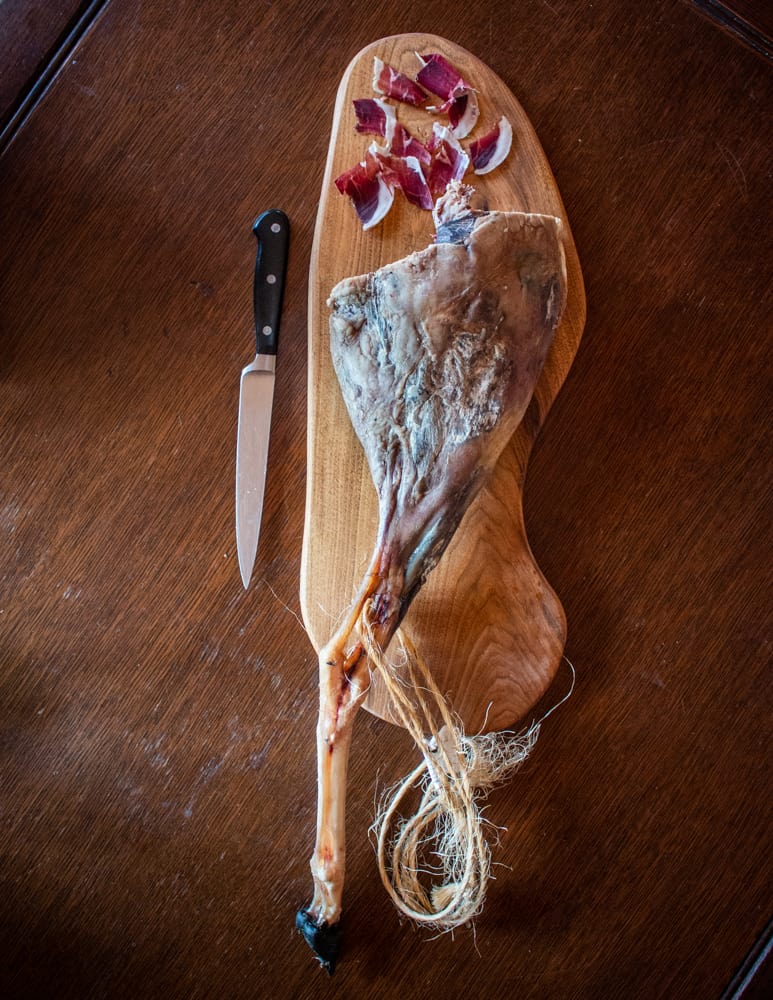 Salting and Curing
Salting and Curing 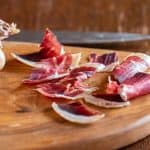
Zsolt
Hi Alan,
Is there a way to dry cure or smoke lamb or mutton’s leg during summer rather than winter?
Alan Bergo
Yes. During the summer here’s what I’d do. Cut the shank off and get the leg into a manageable size. Cure the shank with salt as I describe here. You can smoke it if you want, just make sure the temp is very low. I might do it 24 hours or so. Vacuum seal the entire leg in an Umai Dry bag and proceed until the desired weight is lost. These bags allow moisture to escape while they’re refrigerated so you can dry age and make charcuterie at home.
Zsolt Dudas
Amazing. Thank you!
Susan T.
First, thank you for exploring this and posting about it. I was excited to find it late last fall and apply it to one of my venison hams. That said, I do have a question or two.
For some context, I have my leg hanging in our cellar (we have a very old farmhouse in rural west Michigan complete with a fieldstone walled "basement" and clay floors) and it's a consistent 54 degrees Fahrenheit (humidity is not controlled). I followed your recipe above, and it's been hanging now just over a month, losing just under a pound, so far.
Initial checks over the first month showed no signs of mold whatsoever but within the last week or so, I've found one spot front and center of the ham that initially had two small tufts of what appear to be white mold.
I've been checking it more often and have watched said tufts of white mold turn to one spot of predominantly green mold and one spot of strangely flat, patchy bright yellow (maybe even chartreuse-colored) mold.
There are a few other places on the ham that has sparse and fluffy white mold now but, I'm curious about your thoughts on these two non-white molds...
When does one assume the ham is a loss based on the mold formations and, does this indicate a previous step in the process that I might improve or do differently for future attempts to be more successful?
Thanks in advance for reading this—I know I wrote a lot.
Alan Bergo
Hey Susan. I'm glad you gave the venison ham a shot. Here's my advice: trim the moldy parts off, and blot the area with vinegar. The white mold should colonize, and is natural. In the future, if you find the place you hang it is too warm, or you have trouble with mold, try innoculating it with bactoferm. Just a tiny pinch of bactoferm added to the salt will encourage innoculation of beneficial bacteria and ward off the baddies. Tiny amounts of other molds can occur, especially if it is in a warm-ish area, you don't need to toss the ham if you can stay on top of them, trimming off and blotting with vinegar as needed. Hope that helps.
Susan T.
Thanks so much for the reply (and pardon the slow response).
The advice helped and I appreciated it — I did trim and blot and have been fairly successful since. There were a few other spots that cropped up but, I treated them similarly and it's been very small, seemingly superficial stuff. I did notice its consistently where muscle groups cross and overlap. Perhaps next go-round, I can include the bactoferm (thanks for that!) and I'll make sure to try and tuck the salt deeper into those muscle gaps.
The warm-ish area is certainly a thing; it's starting to warm up here in Michigan and our cellar has slowly gone from a desire-ably consistent temp to just above. I'll have to figure out another space for next fall's venison but, excited to see how this wraps up.
One final curiosity though...I've had some foodie friends inquire about whether or not I'm worried I'll somehow make myself or others sick, and one chef-friend brought up botulism. Am I just bumping up against some modern idea of food that isn't from the super market being "scary" or do any of these inquiries have some inkling of truth?
I have a few older meat curing books and, also spent a little time digging the internet but it seemed like botulism was only mentioned rarely, if at all (and I think it was in relationship to a different treatment of cold-smoking for fish).
Anyhow, curious your thoughts when you have time (I'm not worried btw, just curious if I'm being overly cavalier about something I'm new to). Thanks for reading this, and for the advice.
Cheers!
Alan Bergo
So, I'm not going to speculate on the specifics of botulism. But I think it should say something that I post charcuterie and ferments on my website, and if someone died from them, they could sue my LLC. I am confident in my descriptions and methods here, confident enough to wager my reputation and business on it.
People have been curing meat for a very long time. I don't go into all the in depth specifics on ever solitary thing since there's only so much room in a blog post. My charcuterie recipes are designed for those who have a passing to intermediate experience with charcuterie, and knowledge of basic best practices: when in doubt, throw it out, follow the recipe, and trust your instincts. With the recipe here, I would go back to mentioning that this method is actually safer in many ways than something like pork prosciutto, which is longer, and would need to cure during the warm months. Venison, lamb and goat legs are typically smaller, so they cure faster.
Again, yes, get the Bactoferm. It is basically a fool-proof inoculation method, although you will get eventually get the same sort of beneficial bacteria whether you use it or not. Also, this recipe is smoked, which means that it has an added layer of curing from the nitric acid created by the smoking process. People have been curing meat like this for a very long time, and personally I'm more skeptical (and scared) of Ecoli on tomatoes or lettuce from improper handling and contamination.
If you do not feel comfortable eating your own charcuterie, I would suggest you get some books on the topic. Michael Rhulmans Charcuterie is a good place to start and deals with a number of whole muscle cures.
Another thing that I haven't mentioned that I'm going to feature in an upcoming post this year you may find helpful is using ">Umai bags. I've been working with the company for a number of months now, and it is just a fantastic product. Your fridge regulates humidity and temperature, and if you can fit a leg in one of their bags, or heck, even just wrap it, or, even just put the leg in the fridge, you can hedge your bet and really get good colonization of your bacteria months before you hang it. Heck, you don't even need to hang it if you use an Umai bag, but fridge real estate can be a premium if you don't have a spare one just for cured meats.
Susan
Thanks again for the reply — I appreciate it. I also want to reiterate (and underline) that by no means am I implying anything negative here, regarding the recipe, your business or your personal knowledge, experience or reputation.
On the contrary, I was genuinely curious your opinion (and appreciative of it) — I hadn't an overly informed reply when questioned and thought I might inquire.
I'm comfortable (and considerably excited about) consuming this venison leg, Between your recipe/blog here, and the reading I did leading up to this, I feel confident in my approach (and equally recognize it's by my own volition that I chose to attempt this large cure in the first place and that no one is responsible for the outcome but me).
That said, I will add the Michael Rhulmans book to my collection, and am eager to read about your exploration with the Umai bags!
Az Zul
OMG...looks delicious!! Lamb prosciutto is my favorite. I grow up on that kind of meat. It was must...every winter. Never found it to buy here in USA. Do you know where I can buy such delicatessen here in USA? Thank you!
Alan Bergo
Try to find a Scandinavian grocer, or just use prosciutto. You might try googling "fendelar" and seeing if you could get some by ordering.
Az Zul
I found it!! I didn't know that lamb prosciutto is a specialty in Norway, but in Bosnia and Herzegovina it is a tradition...Lamb, beef, and goat prosciutto. Thank you!!
Ped
Cure #2 is predominately sodium nitrate not nitrite though it does contain nitrite, cure #1 contains nitrite which is used for short term curing i.e. Bacon and cold smoking and yes you do not need cure #2 for whole muscle curing.
Alan Bergo
So you’re saying I’m correct but I mixed up nitrite and nitrate. 🙂 Thx for pointing it out, I always mix those too.
Ped
Yes but a very important differentiation, nitrite is for short curing nitrate for long curing, if you use nitrate for short curing it does not have time to break down into nitrite and there can be potential health risks (this is a very simplified explanation)
Lenny Russo
Allow me to jump in here and clarify some the the things we did and the chemistry we employed at Heartland.
Your memory serves you correctly. We did use wild boar to make our prosciutto in place of or alongside domesticated pig breeds on occasion, but we also used lamb. I can't recall if we ever made venison prosciutto, but my guess would be we did not due the lack of body fat present in the legs. We did used venison for sausage and coppa. You might have some of those recipes. If not, I am happy to pass along what I have should you be interested seeing them.
As for domestic pig breeds, we used a wide variety of breeds which caused variations in how long we hung them due to differences in size, age and body fat percentage when harvested. Following initial fermentation, a leaner breed such as a Berkshire, Hampshire or Yorkshire would hang for 12 to 18 months depending upon the size of the leg. Those breeds have essentially been bred as "meat breeds" as opposed to "fat breeds" which were bred primarily for curing. For example, a "fat breed" Mangalista leg is approximately 60% body fat and would hang for almost 30 to 36 months. You might recall that we crossed European wild boar with Chinese Meishan to produce Swabian Hall. Those legs were usually right around 24 months.
Regarding the fermentation process, that is when we removed the aitch bone and pushed the blood out of the large vein that runs the length of the leg. We packed the opening with coarse sea salt and a starter culture, such as Bactoferm, in order to spur lactobacillus fermentation. Over the years, the starter culture wasn't needed because the ambient air contained enough culture to spur the fermentation, but we used it anyway because it was part of our HAACP plan. The legs were placed on wood dowels and allowed to ferment in our meat locker at 40 degrees Fahrenheit for up to a year before they were washed and larded. The larding consisted of rendered pork fat mixed with black pepper. Cornmeal was used a binding agent. The fat served to keep the surface of the ham from drying out and cracking while the black pepper served as an insect repellent should a housefly or some other winged creature find its way into the curing room. That's a classic Italian technique.
You might recall that the curing room was keep at high humidity, usually 68% to 70%, and a fairly constant cellar temperature of 65 to 68 degrees Fahrenheit. The high humidity slows the curing process and allows for the exterior of the ham to cure at roughly the same rate as the interior. This process is essential to safely curing a ham since it is reducing the water activity to a point that Listeria cannot propagate. Whether the leg is skin on or skinned, it is still capable of producing a hard shell if the exterior of the ham dehydrates too quickly. That would make the ham unsafe to consume. The flavoring of the ham is done during the fermentation while the curing is the preservation of the meat.
Alan Bergo
Thanks Boss. Yes I couldn’t exactly remember where the cornmeal came in. Helpful to know about the aitch bone timeline too, since I didn’t remember when those came out. At 3 months, this is hardly the real deal that you instructed the team to make at Heartland, but I was pleased with the outcome.
Alan Bergo
Again, thanks for correcting me on a few things here, I edited the article for clarity.
Lenny Russo
I am emailing the photo of wild boar prosciutto that we had framed and hanging over counter in the market. I have some photos of the curing room as well if you are interested.
Carla Beaudet
Interesting. I guess what makes it possible to leave the skin on for the pork is that they are relatively less hairy, but pigs still need to be scalded and then scraped to remove the hair. Any idea whether that might be a viable approach for venison?
Alan Bergo
As I write this I'm tending a fire, the embers of which I'm rolling around venison trotters on, fur and all, to make a sort of Native American soup that includes marrow and collagen in the hooves. Scorching with a torch might work, but I think a better approach would be to use an electric clippers and shave it, then hit it with a razor to get the majority of the fur. Once the majority is removed, I'd think it could work better like that, but that will have to wait until I have another deer with the hide on.
Carla Beaudet
Excellent! I am curious now, about whether you can turn out a grit-free trotter broth. Regarding hams, I thought about scorching with a torch, like you mention, but the concern is that the meat you want to cure might cook. In Nepal, I saw people using a chunk of iron about 3"x4"x1/2" welded onto an iron rod and fitted with a wooden handle to sear freshly killed goats. The chunk was heated in the fire and then pressed to the skin of the goat. A high wattage large soldering iron could be used, maybe? I assume they were singeing the hair, but I didn't try to ask anybody about what they were doing. Actually shaving the skin is an idea so crazy it might work?